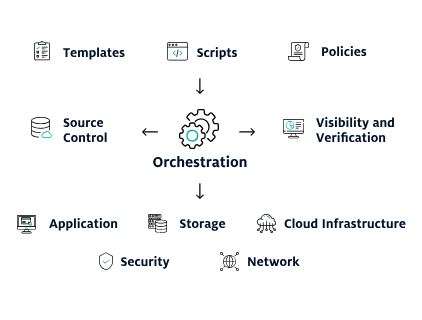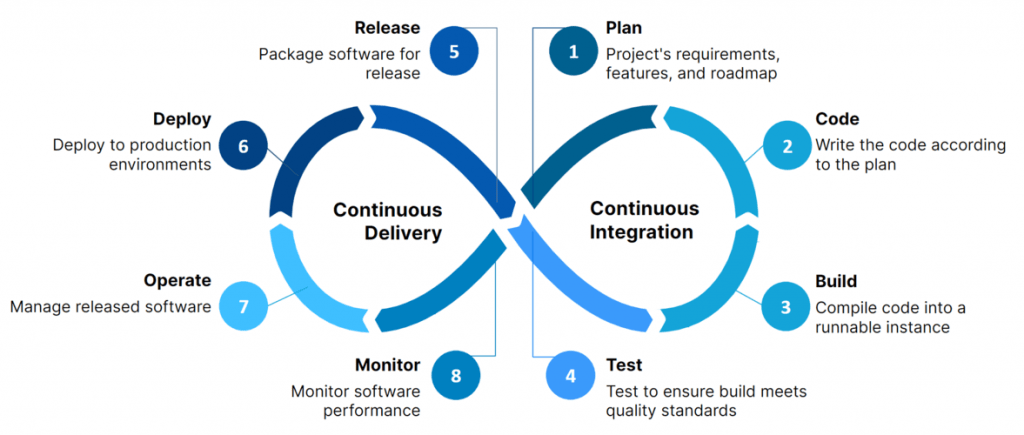
- Introduction to Infrastructure as Code (IaC)
- Benefits of Using IaC in Cloud Computing
- Key Tools for IaC (Terraform, CloudFormation, etc.
- IaC vs Traditional Infrastructure Management
- Writing and Managing IaC Scripts
- Security Considerations in IaC
- Role of IaC in DevOps and CI/CD
- IaC in Multi-Cloud Environments
- Case Studies on IaC Implementation
- Future Trends in Infrastructure as Code
- Conclusion
Introduction to Infrastructure as Code (IaC)
Infrastructure as Code (IaC) is a modern approach to managing and provisioning computing infrastructure through machine-readable definition files rather than physical hardware configuration or interactive configuration tools. It is a practice within cloud computing and DevOps that allows for automation, consistency, and efficient IT infrastructure management. With IaC, infrastructure setup (such as servers, networks, databases, and storage) is described using code. This makes it possible to treat infrastructure like software, enabling version control, automation, and more predictable deployments. Instead of manually configuring servers, you can write code to define and provision the infrastructure automatically, reducing errors, improving scalability, and enhancing consistency.
Benefits of Using IaC in Cloud Computing
- Consistency and Repeatability: IaC allows for consistent infrastructure configuration across environments (dev, test, prod). Since the configuration is code, it can be reused to provision identical environments every time, eliminating discrepancies between environments.
- Automation and Speed: Automating infrastructure setup reduces manual intervention, accelerates deployments, and minimizes human errors, all of which are key topics in a Cloud Computing Course. This leads to faster resource provisioning and more agile development cycles.
- Scalability: IaC enables rapid scaling of infrastructure in response to demand. Cloud environments are often dynamic; with IaC, new servers, networks, and storage can be quickly added or removed as needed.
- Version Control: Just like code, infrastructure definitions can be version-controlled. Infrastructure changes are tracked, and previous versions can be reverted if needed, enhancing security and auditability.
- Cost Efficiency: By automating infrastructure provisioning and scaling, IaC helps optimize resource allocation, which can reduce infrastructure costs. Resources are provisioned as needed and decommissioned when no longer required, ensuring cost savings.
- Collaboration: IaC promotes collaboration between development, operations, and IT teams by making the infrastructure definitions transparent and sharable. It allows for shared knowledge and reduces the communication gaps that often exist between teams.
- Declarative configuration language (HCL).
- State management to track infrastructure resources.
- Strong ecosystem and community support.
- Native to AWS, with deep integration into AWS services.
- Supports both declarative and imperative configurations.
- Stack management for organizing and deploying resources.
- Simplicity of syntax (YAML).
- Works well for both IaC and configuration management.
- It can integrate with other tools like Terraform for full-stack automation.
- Use of familiar programming languages.
- Supports multi-cloud environments.
- Real-time updates and state management.
- Extensive support for system configuration.
- Declarative or procedural code styles.
- Strong integration with a variety of cloud providers.
- Automation: Manual setup and configuration are typical of traditional infrastructure management, while IaC uses code to automate the whole process.
- Consistency: The traditional approach can lead to configuration drift over time, which causes environments to be inconsistent. IaC guarantees that the infrastructure is provisioned in the same manner acr.
- Speed: IaC significantly reduces the time required to deploy infrastructure compared to traditional methods, where provisioning can take days or weeks.
- Cost: IaC leads to better resource management, as resources can be provisioned and decommissioned automatically, minimizing costs, a key concept explored in a Cloud Computing Course.
- Modularity: Structure infrastructure scripts into more discrete, reusable modules. This simplifies code maintenance and sharing between projects.
- Version Control: Store IaC code in version control systems like Git to track changes, roll back versions, and collaborate efficiently with teams.
- Environment-specific Configurations: Use variables or parameterized templates to allow the same code to deploy infrastructure across different environments (development, staging, production).
- Documentation: Provide clear documentation for each part of the infrastructure code, explaining why specific configurations were chosen.
- Automation of Deployments: IaC automates infrastructure deployment as part of CI/CD pipelines, reducing manual intervention and the risk of human error.
- Faster Feedback Loops: Changes to the infrastructure can be automatically tested, validated, and deployed as part of the CI/CD pipeline, ensuring that infrastructure issues are caught early, including those related to Data Movement and Transformation in Azure Data Factory.
- Consistency Across Environments: IaC ensures that the infrastructure is consistent across all environments (development, testing, production), essential for DevOps practices.
- Scalability: IaC supports dynamic infrastructure scaling, a key requirement for DevOps pipelines in cloud-native environments.
- Spotify: Spotify uses IaC to manage its infrastructure on Google Cloud. Using Terraform, Spotify automates the provisioning of virtual machines, storage, and networking resources, significantly speeding up deployments and ensuring consistency across environments.
- Adobe: Adobe utilizes CloudFormation for IaC in AWS to provision resources for its creative cloud offerings. IaC allows Adobe to scale its infrastructure based on demand and automate complex setups, reducing manual configuration and human errors.
- AI and Machine Learning Integration: As AI and machine learning technologies improve, we might see advanced IaC tools that automatically optimize infrastructure configurations based on usage patterns and demand predictions.
- Serverless Infrastructure: With serverless computing rising, IaC tools may evolve to manage better serverless environments where resources are provisioned and decommissioned dynamically, as outlined in the Guide to AWS SSO for seamless access management.
- More Cloud-Native IaC Tools: As more organizations move to the cloud, we can expect the development of even more specialized IaC tools tailored to specific cloud providers and services.
- Improved Security Features: Future IaC tools will likely include more advanced security features, such as automated security testing and enhanced compliance checks for sensitive infrastructure components.

To Explore Cloud Computing in Depth, Check Out Our Comprehensive Cloud Computing Online Course To Gain Insights From Our Experts!
Key Tools for IaC (Terraform, CloudFormation, etc.)
Terraform:
Terraform, developed by HashiCorp, is one of the most popular IaC tools. It is cloud-agnostic, meaning it can work with multiple cloud platforms (AWS, Azure, Google Cloud, etc.) and supports a wide range of services.
Features:
AWS CloudFormation:
CloudFormation is an Amazon Web Services (AWS) service that allows users to define and provision AWS infrastructure using a JSON or YAML template.
Features:
Ansible:
Ansible is an open-source automation tool for configuration management and application deployment. It is agentless and uses YAML-based playbooks to define infrastructure.
Features:
Pulumi:
Pulumi is a modern IaC tool that defines infrastructure using general-purpose programming languages (JavaScript, TypeScript, Python, Go, etc.), and AWS Transit Gateway Simplifying Network Connectivity is one of the use cases where Pulumi can be leveraged to manage and simplify network architecture in AWS.
Features:
Chef and Puppet:
Chef and Puppet are well-established tools providing infrastructure automation and configuration management. They have evolved to support IaC as part of their offerings.
Features:
IaC vs Traditional Infrastructure Management
In conventional infrastructure management, IT infrastructure is manually controlled via physical hardware configurations or GUIs. Such configurations require much manual intervention, resulting in human mistakes, inconsistencies, and an inability to scale.
Main distinctions of IaC from classical infrastructure management:
Writing and Managing IaC Scripts
Coding IaC scripts generally means that the infrastructure desired state is encoded in code, usually through a domain-specific language (DSL) or a general-purpose language (in tools such as Pulumi). IaC script considerations for writing and maintaining:
Interested in Obtaining Your Cloud Computing Certificate? View The Cloud Computing Online Course Offered By ACTE Right Now!
Security Considerations in IaC
While IaC brings significant benefits, it also raises security concerns that need to be addressed. IaC often requires using credentials (e.g., API keys, passwords).These should never be hardcoded in scripts. Instead, use environment variables, secret management services (like AWS Secrets Manager or AWS DataSync), or encrypted storage for sensitive data. Proper role-based access control (RBAC) should be enforced to limit who can modify IaC scripts and deploy infrastructure.

Automate security scanning of IaC scripts to detect vulnerabilities or misconfigurations early in the development process.Enforce policies and use automated tools to ensure that IaC configurations adhere to security and regulatory compliance standards (e.g., HIPAA, GDPR).
Role of IaC in DevOps and CI/CD
IaC is integral to DevOps and Continuous Integration/Continuous Delivery (CI/CD) pipelines. IaC supports DevOps by promoting collaboration between development and operations teams and enabling faster, more reliable infrastructure provisioning.
Looking to Master Cloud Computing? Discover the Cloud Computing Masters Course Available at ACTE Now!
IaC in Multi-Cloud Environments
IaC enables organizations to deploy infrastructure across multiple cloud providers (multi-cloud environments), providing flexibility and reducing the risk of vendor lock-in. Use cloud-agnostic IaC tools (such as Terraform or Pulumi) to deploy infrastructure across multiple cloud providers (AWS, Azure, Google Cloud, etc.). IaC ensures that multi-cloud environments are provisioned consistently, reducing configuration drift and providing unified management. Multi-cloud setups enable redundancy and disaster recovery, and IaC allows these environments to be provisioned automatically, with the added benefit of leveraging GitLab Guide Features & Setup for streamlined management and deployment.
Case Studies on IaC Implementation
Future Trends in Infrastructure as Code
Want to Learn About Cloud Computing? Explore Our Cloud Computing Interview Questions & Answer Featuring the Most Frequently Asked Questions in Job Interviews.
Conclusion
In conclusion, Infrastructure as Code (IaC) has revolutionized how cloud infrastructure is managed. It enables greater automation, scalability, and consistency, making it a cornerstone of modern cloud computing, DevOps, and CI/CD practices. By treating infrastructure as code, organizations can version control their configurations, reduce human error, and ensure reproducibility across environments. Furthermore, IaC fosters collaboration between development and operations teams by providing a single source of truth, enhancing transparency and efficiency, which is often covered in a Cloud Computing Course. It also supports cost optimization by allowing infrastructure to be provisioned and de-provisioned dynamically based on demand, reducing unnecessary resource consumption.As the industry evolves, IaC will continue to play an essential role in streamlining infrastructure management and enabling faster, more reliable deployments. With the rise of AI-driven automation, policy-as-code, and GitOps methodologies, the future of IaC looks even more promising, driving further innovation in cloud computing and IT operations.





